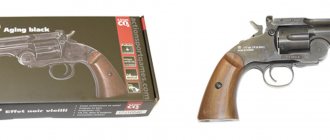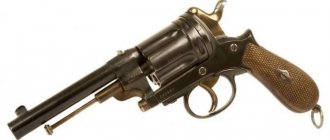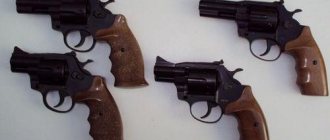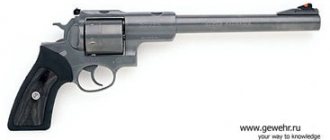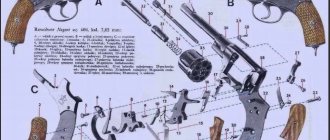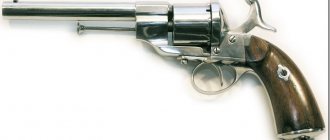A zigzag of failure: the Webley-Fosbury automatic revolver and others with it
Six-shot Webley-Fosbury revolver of .455 caliber, model 1901 and the same year of manufacture. Royal Arsenal, Leeds, UK
“In Kansas, a man named George W. Smith, from the bay, gathered two hundred farmers, armed with shotguns and sporting rifles, and a ridiculously small number of automatic revolvers, and led them to set fire to the mini barracks, Sinclair Lewis
History of Firearms.
The appearance of this material was immediately preceded by two circumstances: the first was the request of one of the readers of the article about the Mauser revolver to write about other types of weapons, the same revolvers that had zigzag grooves on the drum.
The second is related to the memory of books read.
There are a number of books (in particular, Sinclair Lewis’s famous cautionary novel “We Can’t Do It Here”) in which automatic revolvers appear.
And here the main question arises: were they there?
Did they really exist or was it a mistake made by an idle novelist?
The last question is the easiest to answer. Yes, automatic revolvers really existed. This is not fiction.
But what kind of revolvers were they, and how did their automation work? We will talk about this today.
Revolver "Webley-Fosbury" model 1903 Royal Arsenal, Leeds, UK
This unusual weapon, combining the qualities (both good and bad) of both a revolver and a semi-automatic pistol, was the brainchild of British Colonel G. W. Fosbury.
He received a patent for his revolver on August 16, 1895, and then, having slightly refined its design, he patented it again in June and October 1896.
That is, this revolver is the same age as the famous Mauser pistol and, obviously, at that time a number of designers tried to find an opportunity to automate the operation of both pistols and revolvers.
Fosbury didn’t have to look long for the manufacturer: when he turned to Birmingham, they listened to him with great attention. A year later, the company changed its name, and already in July 1900, serial production of the Vincent Fosbury revolver began, which received the following name: “Webley-Fosbury Automatic Revolver.”
It was produced for a relatively long time, until 1918, and during this period about 4,750 copies of these revolvers were produced. However, this revolver was never in service with the British army, as it had one difficult defect: in the event of a cartridge misfire, it was impossible to turn the revolver cylinder manually.
Model 1914. The sports version of the revolver, with a barrel length of 190 mm, had an even softer trigger and even more accurate automation. Its shooting accuracy was simply unattainable for other self-cocking revolvers, since turning the drum in them required significant effort not only from the index finger, but also from the entire hand. Therefore, he was very loved by sports shooters. However, due to its obvious superiority over other service models, its use was recognized as “not sporting”, and was banned in 1918, thereby driving the last nail into the coffin of at least such success! Royal Arsenal, Leeds, UK
The revolvers were produced chambered for .455 and .38 calibers (six and eight rounds, respectively) and with barrels of various lengths: 190 mm and 152 mm, but there was also a model with a barrel only 100 mm long.
Although they were not accepted into service, many British officers purchased them privately. So they smelled gunpowder both during the Boer War and during the First World War, where, in addition to officers, they tried to arm observer pilots of British airplanes with them.
And this is how he reloaded using a clip! Royal Arsenal, Leeds, UK
Be that as it may, this revolver was the first revolver in which, for reloading, the recoil force generated by each successive shot was used both to rotate the cylinder and at the same time to cock the hammer for the next shot. That is, when shooting by self-cocking, the shooter did not have to forcefully press the trigger in order to simultaneously turn the revolver drum and cock its hammer.
Diagram of a revolver from the US patent issued to Colonel Fosbury for his automatic revolver: Fig.1 – The upper part of the revolver frame is in its original position before firing. Fig.2 – The upper part of the frame moves back under the action of recoil, while it cocks the hammer and turns the drum.
This was achieved due to the fact that the frame of this revolver was constructed from two parts.
The lower one consisted of a handle with a trigger mechanism, a spring and guides on its upper part.
The upper part of the frame consisted of a barrel and a drum, and it could slide along the guides of the lower part, but was held in place by a spring.
During recoil, a special pin attached to the lower frame followed the zigzag grooves on the drum and turned it so that the next loaded chamber stood opposite the barrel. At the same moment the hammer is cocked.
When all the ammunition in the cylinder was expended, the revolver could be reloaded by pressing the barrel lock and turning the barrel down on a hinge, thus tilting the rear of the cylinder up. At the same time, the automatic extractor immediately pulled out the empty cartridges from the drum chambers.
That is, it was a system similar to all other Webley revolvers and Smith and Wesson revolvers.
Types of guide zigzag grooves of the drum of revolvers of different years of production: 1 – “Webley-Fosbury” M 1901 caliber .455, 2 – “Webley-Fosbury” M 1901 caliber .38, 3 – “Webley-Fosbury” M 1902 and “Webley-Fosbury” » M 1914
The cartridges could be inserted into the drum either one after another, or all at once, using a flat steel clip, after which the barrel was raised and locked. After this, the revolver could fire after pressing the trigger, and for the first shot the hammer was cocked manually. But then it was enough to press the trigger, without putting much effort on it, so that shots from it would follow one after another.
Webley-Fosbury revolvers also had a manual safety lever located on the left side of the handle.
Leather holster for a Webley-Fosbury .38 caliber revolver
In fact, this revolver did not have too many advantages over contemporary revolvers of the same caliber.
The main advantages were less recoil (due to the fact that, firstly, it was absorbed by the spring, and secondly, due to its greater weight - 1.23 kg) and improved accuracy during automatic shooting, which in conventional self-cocking revolvers was unattainable.
However, the mechanism was quite sensitive to dirt and especially suffered from sand getting into it. And its reloading was not much faster than that of contemporary revolvers, despite the fact that special flat clips were developed for this weapon, simultaneously holding six .455 or eight .38 caliber cartridges.
Characteristic “zigzag” grooves on the revolver drum, ensuring rotation of its drum
The proverb states that “bad ideas are contagious,” although it cannot be fully applied to the above-mentioned revolver.
But still, he did not enjoy mass success.
Nevertheless, this design had imitators. And not just anywhere, but overseas, in the USA, where in 1909, the designer Charles Lefevre, one of the sons of the founder and owner of the American Lefevre Arms Company, Daniel Lefevre, known for his invention of the hammerless gun, created the Union revolver, as two peas in a pod similar to Webley-Fosbury.
Advertisement for the Union revolver
However, he was still different from him in some ways.
First of all, in size - it was significantly smaller both in size and in caliber: it fired .38 Smith and Wesson cartridges.
He received an American patent for it and was able to organize its mass production at his father’s company.
The revolver cost $10, which is not so little for such a “baby” who, among other things, looked completely unremarkable.
It operated in exactly the same way as the Smith and Wesson (unloading) and like the Webley-Fosbury (automatic), but it was simpler in design, and also had a box in the rear, into which the movable upper part of the frame rolled back. In this it was more convenient than the British revolver.
But nevertheless, it did not enjoy much success in the market. It was produced for only three years, after which its production ceased.
Appearance of the Union revolver
All these are classic revolvers, although with automatic cylinder and trigger drive.
However, there was a man - his name was Halvard Landstad, who created an automatic revolver, patented in Norway in 1899 (Norwegian patent 8564, April 11, 1899), which was, in fact, not so much a revolver as a pistol (magazine in the handle). But at the same time, it is also a revolver (the drum and the presence of a cartridge in it at the time of the shot).
That is, Landstad managed to “cross a snake and a hedgehog” quite well and get a completely workable design.
Appearance of a Landstad revolver. Pay attention to the drum pusher connected to the trigger: when the hook moved back, it pressed on this pusher, which rose up, turned the drum over and at the same time, at the very end, released the trigger!
His drum had only two chambers - upper and lower, and was a “flat box”. A longitudinally sliding bolt sent a cartridge from a box magazine in the handle into the lower chamber, and then when the trigger was pressed, the drum rotated 180°, and a shot was fired from the upper chamber. Then the bolt, under the influence of recoil force, moved back, ejected the empty cartridge case from the upper chamber and at the same time loaded the lower one.
Thus, unlike other systems, this weapon automatically performed the full loading cycle, including cartridge case extraction.
Landstad revolver design diagram
The Landstad revolver was tested in Norway, but never entered service.
The magazine was small: only six 7.5x23R cartridges, and besides, it was inserted not from the bottom, but from the side on the left, which was completely inconvenient. There was no safety on it, but the long travel of the trigger made it unlikely. A shot could not have occurred when this revolver-pistol fell on a hard floor, since there was never a cartridge in the upper chamber opposite the barrel. It only got there at the moment of the shot, and because of the flat shape of the drum it could not turn. But that’s where all its advantages ended!
The drum rotates, the bolt striker moves back...
Today there are also automatic revolvers of rather interesting designs. And they not only exist: they are produced and bought. But we'll tell you about them some other time.
A daily boost of fighting spirit!WARHEAD.SU
In 1895, British Army Colonel George Vincent Fosbury developed an automatic revolver. It was produced by Webley and Scott, and the more common but archaic form is Webley and Scott. The company produced Webley revolvers, widely used in the UK by both the military, police and civilians. The weapon was named, accordingly, “Webley-Fosbury”. Production began in 1901.
Drawing from G. W. Fosbury's patent for an automatic revolver
Unlike conventional revolvers, where the entire mechanism was driven by the muscular force of the shooter, the Webley-Fosbury used the power of powder gases. During the shot, the upper part of the revolver (barrel and drum) moved back under the influence of recoil. At the same time, the hammer was cocked and the drum was rotated, placing the next cartridge into the barrel. Before the first shot, the hammer had to be cocked manually.
Reloading was carried out in the same way as with conventional Webley revolvers - the barrel and drum were folded forward and down on a hinge, and in the process the spent cartridges were thrown out. Then new cartridges were inserted into the drum, the barrel and drum were returned to their place, and shooting could continue.
Trying to combine the advantages of the two classes, we also combined the disadvantages (just like in life, username: choose your mate carefully). "Webley-Fosbury" did not have the compactness of pistols. Yes, it was even larger than a regular Army Webley Mk IV .455 caliber revolver! At the same time, he managed to lose such advantages of revolvers as instant readiness to open fire and the ability to instantly fire a second time if it misfired, simply by pressing the trigger again. No, there was a lot of tinkering to be done here (no way without Webli, yes). Before the first shot, it was necessary, as on a pistol, to cock the hammer, and if it misfired, it was necessary (again, as when using a pistol) to jerk the bolt - that is, in this case, the drum.
Automatic revolver "Webley-Fosbury"
But not only that, the Webley-Fosbury also turned out to be less reliable than pistols and revolvers combined. It simultaneously featured a complex mechanism that was vulnerable to contamination, as in pistols, and - like revolvers - an open design that allowed contamination to easily enter the weapon.
This seems to be the end of the fairy tale, but the weapon did have some advantages. Firstly, it had a soft recoil (the recoil of the very massive barrel-drum assembly absorbed almost all the energy), and secondly, it had a high rate of fire. So suddenly it became popular with sports shooters, who still don’t need to carry extra weights, crawl through mud, or risk their lives by delaying because of a misfire. The officers also liked him, they even bought him at their own expense. But, in general, the military did not appreciate the new product.
"Webley-Fosbury" .38 caliber, opened for reloading, the mechanism is also visible (when moving, the upper part moves back due to recoil)
Unexpectedly, the use of the iron chimera was found in the air. At the beginning of the First World War, the Webley-Fosbury was popular among aviators. At that time, machine guns were not installed on every airplane, and it was necessary to shoot at the damned enemy from something. Since aircraft move quickly and often along complex trajectories, the weapon must be sufficiently rapid-fire and multi-charged. Typically, Mauser C96 pistols with a capacity of ten rounds were used for this, but automatic revolvers also gained supporters. The Mauser had a non-detachable magazine, loaded from a clip similar in design to a rifle, so the Webley-Fosbury reloaded more conveniently and quickly, especially when using an accelerator. By the way, we wrote about another pistol with which World War I aviators tried to kill each other in an article about the Villar-Perosa M1915 model.
Automatic revolver "Webley-Fosbury"
Webley and Scott, convinced of the unsuccessful outcome of the experiment with an automatic revolver, switched to creating automatic pistols. And here they completely succeeded - their Mk.I pistol was adopted by the British Navy in 1912.
Webley-Fosbury weapons: pistol and revolver in one bottle
At the end of the 19th and beginning of the 20th centuries, self-loading (automatic) pistols replaced revolvers. The first were distinguished by a high rate of fire and smaller sizes. However, the latter were of better quality and easier to use. The idea came up to combine the advantages of both types of weapons. British soldiers took up the matter.
In 1895, an officer of the royal troops G.V. Fosbury created an automatic revolver. It took over its release. The company produced Webley revolvers, which were actively used in Albion by the army, Scotland Yard employees and ordinary Englishmen.
The model was named "Webley-Fosbery". Its production started in 1901.
Compared to standard revolvers, where the mechanism was manually started by the owner of the weapon, the new product used the pressure of gunpowder gases. When fired, the upper part of the model (drum with barrel) moved back under the influence of recoil. At the same time, the hammer was cocked and the drum was rotated, moving new ammunition towards the barrel.
Drawing from G. W. Fosbury's patent for an automatic revolver
Before firing the first shot, the hammer had to be cocked independently. Reloading was carried out according to a principle similar to other “Webley” models - the upper part of the weapon was moved forward and down using a hinge, and the used cartridges were removed from the barrel.
Then other ammunition was placed in the drum, the barrel and drum returned back, and fire could be fired again.
A serious miscalculation was that the designers combined not only the pros, but also the disadvantages of pistols and revolvers. The model could not boast of the small size of an automatic weapon. The Webley-Fosbery was larger in size than even the standard Webley Mk IV .455 caliber military revolver.
At the same time, the new product lost such advantages of revolvers as instant readiness to fire and the ability to fire another bullet, even if it misfired, which required only pressing the trigger again. It became obvious that a major overhaul was needed.
Automatic revolver "Webley-Fosbury"
Before the first salvo, it was necessary, as on an automatic weapon, to cock the trigger, and if it misfired, the owner was forced to distort the drum, which played the role of a bolt in a conventional pistol.
In terms of reliability, the Webley-Forsbery was inferior to both a revolver and a pistol. The presence of an intricate mechanism that is not protected from dirt and the open design in this regard reduced the reliability of the model to nothing.
However, Webley-Forsbury also had its merits.
First of all, it is the low recoil, possible thanks to the bulky barrel-drum combination, as well as the speed of fire. Unexpectedly, the model gained popularity in sports. Here, weapon owners could not die due to a long reload. Some officers also fell in love with it, sometimes purchasing it with their own money. However, in general the army refused to accept the model for service.
"Webley-Fosbury" .38 caliber
Suddenly, pilots became interested in the new product. In the early years of the military confrontation between the Triple Alliance and the Entente, "Webley-Forsbery" was distributed in the Air Force. In those years, only rare aircraft had machine guns, and fighting in the air had to be done somehow.
Since airplanes move quickly and often along intricate trajectories, the weapon had to be spacious and quick to fire.
Often pilots owned a Mauser C96 model, which could hold 10 rounds of ammunition. However, Webley-Forsbury also had fans. The Mauser had an inseparable magazine. The owner loaded it from a clip, which was similar in structure to a rifle clip. Therefore, in this case, “Webley-Forsbery” stood out favorably for the speed and comfort of reloading, especially when using an accelerator.
Automatic revolver "Webley-Fosbury"
, having ascertained the failure of the new product, concentrated on the production of conventional automatic pistols. The company achieved success in this field - the Mk.I model entered service with the English Navy in 1912.
Subscribe to the Military Observer channel in Yandex.Zen
News Media2
Combat and service weapons
The Webley-Fosbery revolver of 1896 was developed for arming the army by the English designer Vincent Fosbery. Fosbury received a patent for his revolver on August 16, 1895, and, after finalizing the design, he patented it again in June and October 1896. In his search for a manufacturer of his revolver, W. Fosbury chose Webley & Son, located in Birmingham, England. In 1897, after the merger of W. C. Scott & Sons and Richard Ellis & Son with Webley & Son, the new enterprise was named Webley & Scott Revolver and Arms Co. It was here that mass production of a revolver designed by Vincent Fosbury began in July 1900, called the “Webley - Fosbery Automatic Revolver.” The revolver was discontinued in 1918, although it was listed in the catalogs of Webley & Scott Revolver and Arms Co. until 1939. In total, between 1900 and 1918, about 4,750 Webley - Fosbery 1896 revolvers were produced. Officially, the revolver was not in service in England due to the fact that in the event of a cartridge misfire, the revolver drum cannot be turned manually.Although the revolver is called the "Webley - Fosbery Automatic Revolver", it would be more fair to call it semi-automatic, due to the fact that only the hammer is automatically cocked. This happens as follows. The shooter cocks the hammer manually only for the first shot. After the shot, the block, consisting of the upper part of the revolver frame, barrel, drum and part of the trigger, rolls back. In this case, a shaped protrusion located under the drum, which is part of the lower frame of the revolver, interacts with a zigzag groove on the outer side of the drum, and turns the retracting drum half a turn between its chambers. Having reached the rearmost position, the upper block, under the action of a plate return spring located in the revolver handle, begins to move forward. In this case, the figured protrusion rotates the drum, aligning its next chamber with the axis of the barrel bore. The hammer remains in the cocked position. The revolver is ready for the next shot.
To reload the revolver, the frame with the barrel and drum is folded forward. In this case, a spring-loaded sprocket located in the central axis of the drum pushes out all spent cartridges at once, hooking them onto the flange. In the Webley-Fosbery revolver chambered for the .38 ACP cartridge, the cartridges are interconnected by rigid plate clips. This is because .38 ACP cartridges are not rimmed. On the left side of the weapon, between the trigger guard and the handle, there is a mechanical safety box. When turned on, it disconnects the trigger and sear. Also on the left side of the trigger there is a lever, when pressed, the revolver frame is unlocked for reloading. The sight is open, not adjustable.

